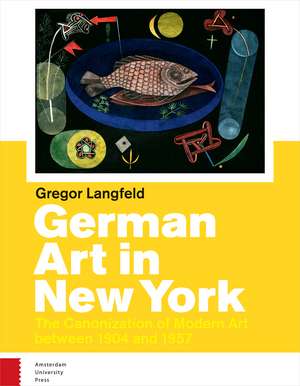German Art in New York – The Canonization of Modern Art 1904–1957
Autor Steven Lindbergen Limba Engleză Hardback – 16 iun 2015
Why did the Museum of Modern Art and the Guggenheim in New York, and art collectors and curators such as Katherine Dreier and Alfred Barr, collect modern German art in the first half of the twentieth century? And why did certain works of art belong to the canon while others did not?
In this book, Gregor Langfeld argues that National Socialism played a crucial role in the canonization of movements such as Expressionism and the Bauhaus. A role which undermined the post-1945 reputations of many artists associated with classical and figurative trends. Langfeld offers important new insights into the political and ideological motivations behind the New York art world's fluctuations in opinion, fashion, and price.Preț: 410.74 lei
Preț vechi: 501.68 lei
-18% Nou
Puncte Express: 616
Preț estimativ în valută:
78.60€ • 81.60$ • 65.54£
78.60€ • 81.60$ • 65.54£
Carte indisponibilă temporar
Doresc să fiu notificat când acest titlu va fi disponibil:
Se trimite...
Preluare comenzi: 021 569.72.76
Specificații
ISBN-13: 9789089647665
ISBN-10: 908964766X
Pagini: 232
Ilustrații: 40 color plates, 100 halftones
Dimensiuni: 179 x 239 x 15 mm
Greutate: 0.66 kg
Editura: Amsterdam University Press
ISBN-10: 908964766X
Pagini: 232
Ilustrații: 40 color plates, 100 halftones
Dimensiuni: 179 x 239 x 15 mm
Greutate: 0.66 kg
Editura: Amsterdam University Press
Notă biografică
Gregor Langfeld is assistant professor of the history of modern art at the University of Amsterdam.
Cuprins
Introduction
Questions and Hypotheses
Methodological Foundations
The Current State of Research
Harvard University
From the First Exhibitions of German Art to the First World War
Promoting German Art in the 1920s:The International versus the National Position
Katherine Dreier
Dreier’s Understanding of Art
International Exhibition of Modern Art (1926–1927)
William R. Valentiner
Valentiner’s Understanding of Art
Modern German Art at the Anderson Galleries (1923)
Promoting German Art around 1930: The National Position
The Harvard Society for Contemporary Art:
Modern German Art and Bauhaus (1930–1931)
The Museum of Modern Art and Alfred H. Barr Jr.
Barr’s Development and Understanding of Art
The Collecting Strategies of the Museum’s Founders
Barr’s Reputation
German Painting and Sculpture (1931)
The Influence of National Socialism on Canonization
Reactions to National Socialist Art Policy through 1937
Barr’s Early Assessments
Art Criticism, 1937
The Canonization of the Bauhaus
Bauhaus, 1919−1928
at the Museum of Modern Art (1938–1939)
Former Members of the Bauhaus in the Educational System
Roosevelt’s Opening Speech at the Museum of Modern Art (1939)
Hilla Rebay and Solomon R. Guggenheim: An Apolitical Perspective
Rebay’s Understanding of Art
Acquisitions
The Reception among Art Critics
Acquisitions of “Exile Art” by the Museum of Modern Art (1939)
Protests by American Artists
Exhibitions of “Degenerate Art” outside of New York (1939–1940)
The Traveling
Exhibition of 20th Century (Banned) German Art
Modern German Art at the Springfield Museum of Fine Arts
Contemporary German Art at the Institute of Modern Art, Boston
The Affirmation of the Canon
The Museum of Modern Art during the Second World War
Free German Art (1942)
The Postwar Era
German Art of the Twentieth Century at the Museum of Modern Art (1957)
The Collecting Strategies of the Busch-Reisinger Museum
The Canonization of Other Art Forms
Looking Ahead
Conclusions
Notes
Bibliography
Acknowledgments
Index of Names
List of Illustrations
Questions and Hypotheses
Methodological Foundations
The Current State of Research
Harvard University
From the First Exhibitions of German Art to the First World War
Promoting German Art in the 1920s:The International versus the National Position
Katherine Dreier
Dreier’s Understanding of Art
International Exhibition of Modern Art (1926–1927)
William R. Valentiner
Valentiner’s Understanding of Art
Modern German Art at the Anderson Galleries (1923)
Promoting German Art around 1930: The National Position
The Harvard Society for Contemporary Art:
Modern German Art and Bauhaus (1930–1931)
The Museum of Modern Art and Alfred H. Barr Jr.
Barr’s Development and Understanding of Art
The Collecting Strategies of the Museum’s Founders
Barr’s Reputation
German Painting and Sculpture (1931)
The Influence of National Socialism on Canonization
Reactions to National Socialist Art Policy through 1937
Barr’s Early Assessments
Art Criticism, 1937
The Canonization of the Bauhaus
Bauhaus, 1919−1928
at the Museum of Modern Art (1938–1939)
Former Members of the Bauhaus in the Educational System
Roosevelt’s Opening Speech at the Museum of Modern Art (1939)
Hilla Rebay and Solomon R. Guggenheim: An Apolitical Perspective
Rebay’s Understanding of Art
Acquisitions
The Reception among Art Critics
Acquisitions of “Exile Art” by the Museum of Modern Art (1939)
Protests by American Artists
Exhibitions of “Degenerate Art” outside of New York (1939–1940)
The Traveling
Exhibition of 20th Century (Banned) German Art
Modern German Art at the Springfield Museum of Fine Arts
Contemporary German Art at the Institute of Modern Art, Boston
The Affirmation of the Canon
The Museum of Modern Art during the Second World War
Free German Art (1942)
The Postwar Era
German Art of the Twentieth Century at the Museum of Modern Art (1957)
The Collecting Strategies of the Busch-Reisinger Museum
The Canonization of Other Art Forms
Looking Ahead
Conclusions
Notes
Bibliography
Acknowledgments
Index of Names
List of Illustrations
Recenzii
“Offers a useful analysis of a key aspect of modern German art heretofore unexplored in the literature. Langfeld clearly outlines the scope of his inquiry, and his approach is well organized and well documented with primary material. . . . Recommended.”
